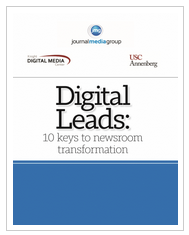I wrote a study of best practices for advertising sales at news startups for the Tow-Knight Center for Entrepreneurial Journalism at CUNY. Here is a post I wrote summarizing key findings, originally published by Knight Digital Media Center at USC Annenberg.
A new report I wrote for the Tow-Knight Center for Entrepreneurial Journalism at CUNY underscores the value of professionalizing ad sales operations at news startups. The report details a number of practices that news startups have either developed or adopted from traditional media. In this post, I highlight three:
1. Professional sales staff
Hiring a sales rep or bringing on a partner to focus on revenue may prove critical to many operations. It is challenging – good sales people are in high demand and compensating them adequately is a stretch for small sites. But the inability to recruit and retain a good sales person may doom a site.
Ask David Boraks, who closed his two local news sites in North Carolina earlier this year.
“Finding a full-time sales person earlier would have made a difference,†Boraks said. “We tried. We couldn’t find the right person who could work for us for what we could pay They were six-figure persons. The other (sales) jobs around here are that. We can’t afford that.â€
By contrast, multiple sites in the study, including Riverhead Local on Long Island, N.Y., and Noozhawk in Santa Barbara, Calif., reported revenue increases when they took steps to improve their sales operations.
2. Realistic rate structure
A rate structure has to reflect revenue requirements of the site and it should be consistent
Kim Clark, vice president for revenue development and partner at Noozhawk said a structure (outlined in a rate card) gives the sales rep has something to share with potential advertisers and set the value of the site. Without a rate structure, “everything is up for negotiation,†Clark said, which is time consuming and makes it harder to track and hit revenue targets.
Clark said the rates have to reflect revenue needs of the site. “You have to stick with an average rate that’s going to get you into the black. Sure, it’s great if you’re making a lot of sales. But at end of the day what does your profit margin look like?â€
3. Avoid CPM pricing
Successful sites have developed a following that enables them to charge premium rates. Most favor multi-month contracts. That time frame means the ads have time to work in raising advertiser visibility in the community and it means sites are not constantly reselling inventory.Â
Long-term contracts assure that “you’re not always reinventing the wheel†in reselling ad inventory, Clark said. “They are advertising long enough to see if it’s effective.”
Noozhawk, charges $1,450 a month for prominent display in high-traffic sections of the site and $165 to $600 a week for run of site advertising, depending on prominence and size. Third Door Media, with its audience of 1.4 million unique monthly visitors, charges $4,000 per week for daily advertising across its network, which includes multiple sites and newsletters. Search Engine Land also offers CPM pricing at rates ranging from $25 to $60 depending on size and placement.
By contrast, sites that rely mostly on CPM (cost per 1,000 impressions) or network rates, struggle.
Budget Savvy Bride, for example, averages $3 per CPM against an audience of 82,000 unique visitors. She Finds, a fashion site, has seen its rate through the Glam network fall as low as $2 against 1.5 million uniques..

